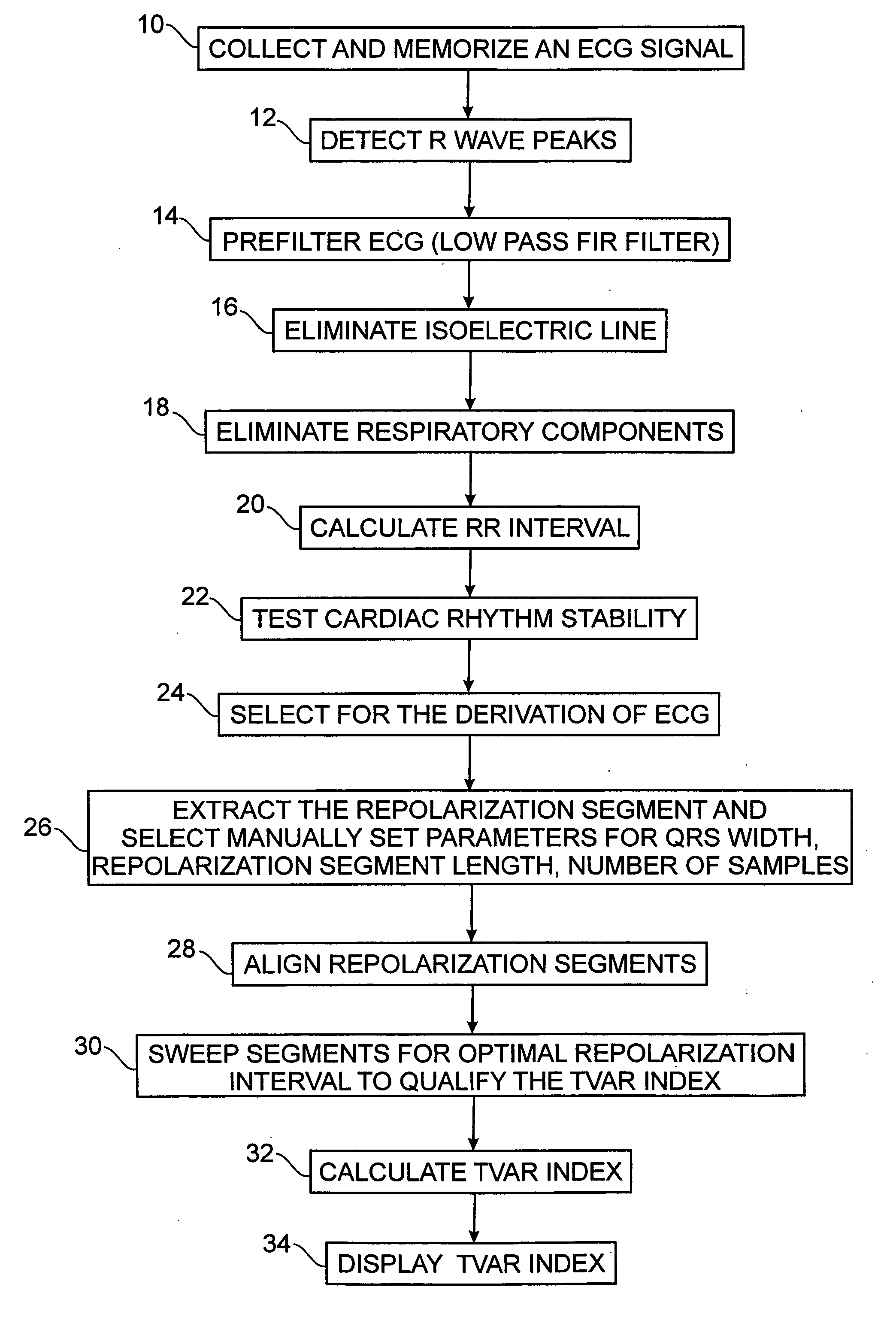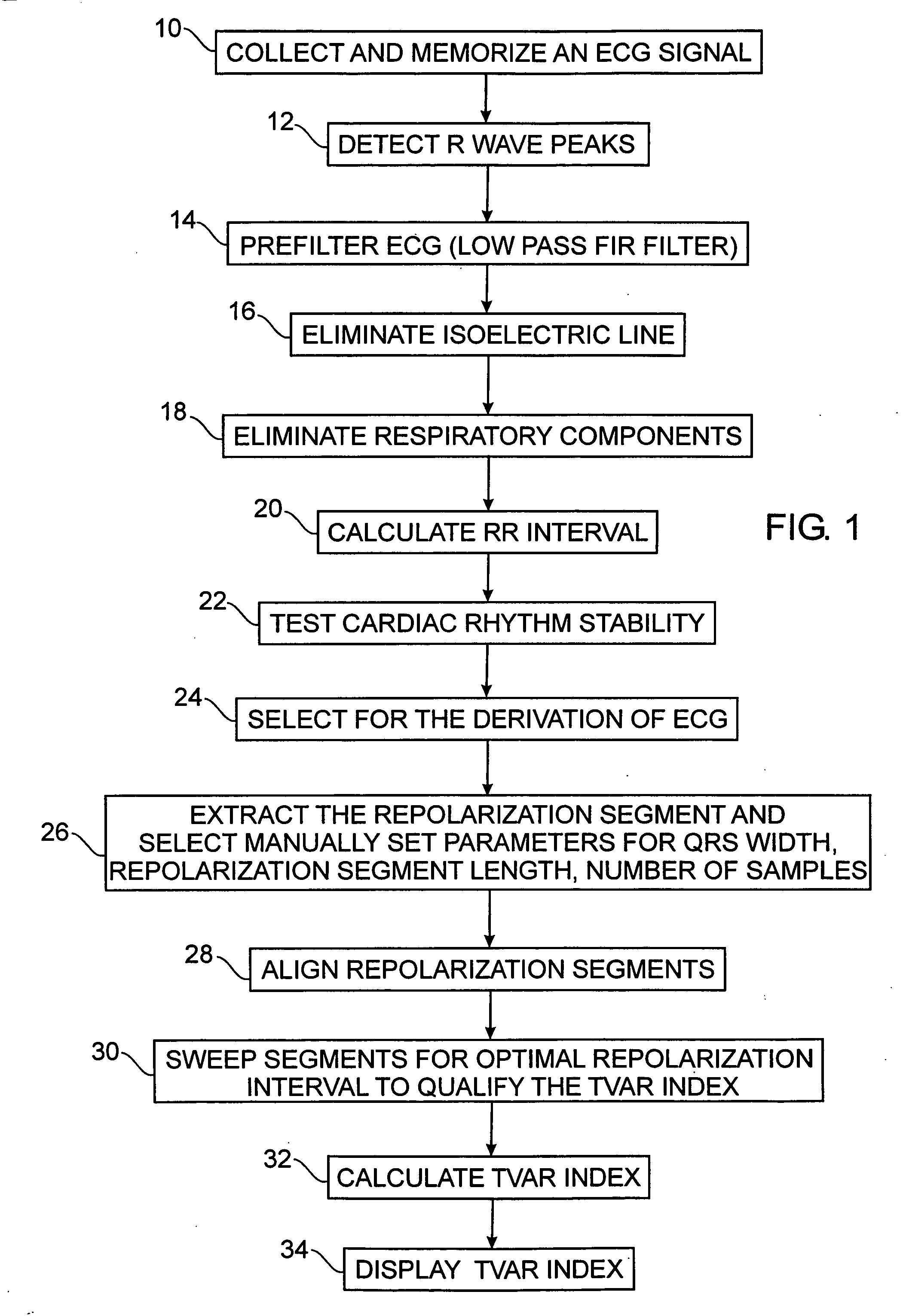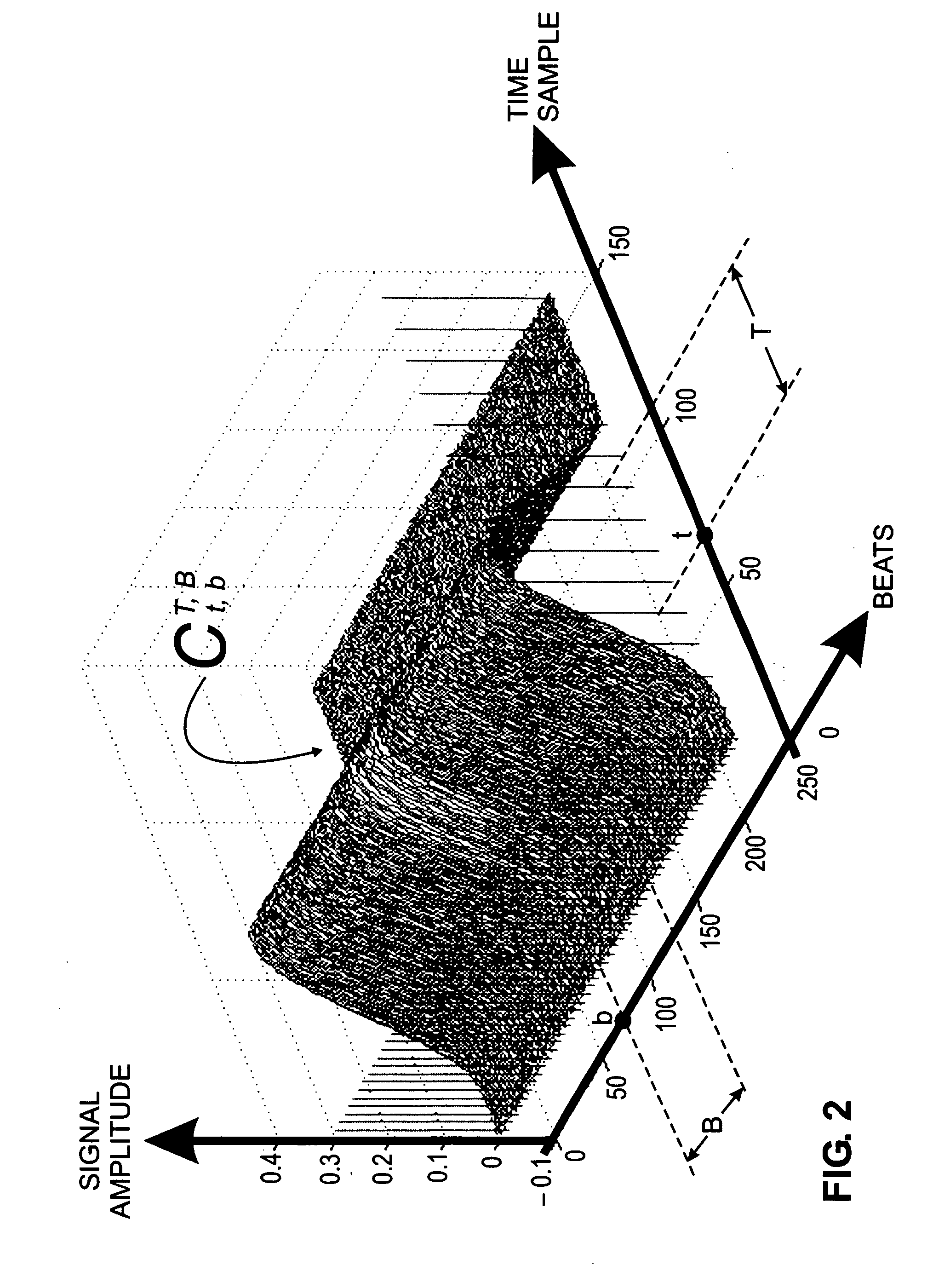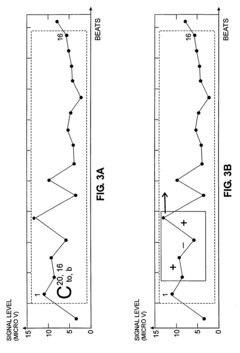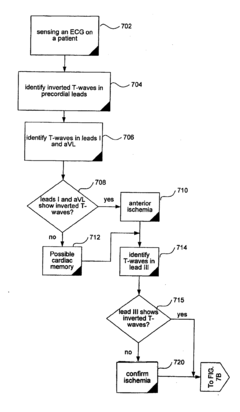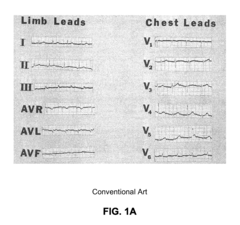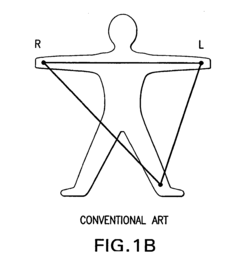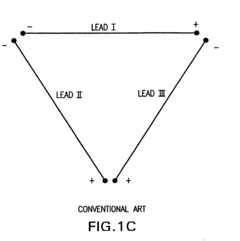Understanding T wave inversion's role in cardiovascular disease progression
AUG 19, 20259 MIN READ
Generate Your Research Report Instantly with AI Agent
Patsnap Eureka helps you evaluate technical feasibility & market potential.
T Wave Inversion Background and Objectives
T wave inversion is a critical electrocardiographic finding that has been the subject of extensive research in the field of cardiovascular medicine. This phenomenon, characterized by the reversal of the normal T wave polarity on an electrocardiogram (ECG), has been observed in various cardiac conditions and has significant implications for cardiovascular disease progression.
The history of T wave inversion research dates back to the early 20th century when the ECG was first introduced as a diagnostic tool. Over the decades, our understanding of this electrocardiographic feature has evolved considerably. Initially, T wave inversion was primarily associated with myocardial ischemia and infarction. However, subsequent studies have revealed its presence in a broader spectrum of cardiac pathologies, including cardiomyopathies, electrolyte imbalances, and even in some apparently healthy individuals.
The technological advancements in ECG recording and analysis have played a crucial role in enhancing our ability to detect and interpret T wave inversions. High-resolution ECG systems and computerized analysis algorithms have improved the sensitivity and specificity of T wave inversion detection, enabling more accurate diagnosis and risk stratification.
Recent research has focused on elucidating the underlying mechanisms of T wave inversion and its relationship to cardiac electrophysiology. Studies have explored the ionic currents and cellular processes that contribute to the generation of inverted T waves, providing insights into the complex interplay between myocardial structure, function, and electrical activity.
The primary objective of current research in this field is to better understand the prognostic significance of T wave inversion in different clinical contexts. This includes investigating its role as a predictor of adverse cardiac events, its utility in risk stratification for sudden cardiac death, and its potential as a marker for subclinical cardiovascular disease.
Another key goal is to develop standardized criteria for interpreting T wave inversions across diverse patient populations. This is particularly important given the variability in T wave morphology among different ethnic groups and age ranges. Researchers aim to establish robust guidelines that can be applied universally in clinical practice.
Furthermore, there is a growing interest in exploring the genetic and molecular basis of T wave inversion. Identifying specific genetic markers associated with this ECG pattern could potentially lead to more personalized approaches in cardiovascular risk assessment and management.
As we continue to unravel the complexities of T wave inversion, the ultimate aim is to translate these findings into improved clinical outcomes. This includes developing more targeted therapeutic interventions, refining risk prediction models, and enhancing our ability to prevent and manage cardiovascular diseases effectively.
The history of T wave inversion research dates back to the early 20th century when the ECG was first introduced as a diagnostic tool. Over the decades, our understanding of this electrocardiographic feature has evolved considerably. Initially, T wave inversion was primarily associated with myocardial ischemia and infarction. However, subsequent studies have revealed its presence in a broader spectrum of cardiac pathologies, including cardiomyopathies, electrolyte imbalances, and even in some apparently healthy individuals.
The technological advancements in ECG recording and analysis have played a crucial role in enhancing our ability to detect and interpret T wave inversions. High-resolution ECG systems and computerized analysis algorithms have improved the sensitivity and specificity of T wave inversion detection, enabling more accurate diagnosis and risk stratification.
Recent research has focused on elucidating the underlying mechanisms of T wave inversion and its relationship to cardiac electrophysiology. Studies have explored the ionic currents and cellular processes that contribute to the generation of inverted T waves, providing insights into the complex interplay between myocardial structure, function, and electrical activity.
The primary objective of current research in this field is to better understand the prognostic significance of T wave inversion in different clinical contexts. This includes investigating its role as a predictor of adverse cardiac events, its utility in risk stratification for sudden cardiac death, and its potential as a marker for subclinical cardiovascular disease.
Another key goal is to develop standardized criteria for interpreting T wave inversions across diverse patient populations. This is particularly important given the variability in T wave morphology among different ethnic groups and age ranges. Researchers aim to establish robust guidelines that can be applied universally in clinical practice.
Furthermore, there is a growing interest in exploring the genetic and molecular basis of T wave inversion. Identifying specific genetic markers associated with this ECG pattern could potentially lead to more personalized approaches in cardiovascular risk assessment and management.
As we continue to unravel the complexities of T wave inversion, the ultimate aim is to translate these findings into improved clinical outcomes. This includes developing more targeted therapeutic interventions, refining risk prediction models, and enhancing our ability to prevent and manage cardiovascular diseases effectively.
Clinical Significance in Cardiovascular Disease
T wave inversion plays a crucial role in the progression and diagnosis of cardiovascular diseases. This electrocardiographic finding has significant clinical implications, particularly in identifying and assessing various heart conditions. The presence of T wave inversion often indicates underlying myocardial ischemia or infarction, making it a valuable marker for detecting coronary artery disease and acute coronary syndromes.
In the context of acute myocardial infarction, T wave inversion can appear in the early stages and persist for weeks or even months after the event. This prolonged manifestation aids in the long-term monitoring of patients who have experienced a heart attack, providing insights into the healing process and potential complications. Furthermore, the specific leads in which T wave inversion occurs can help localize the affected area of the heart, guiding targeted interventions and treatment strategies.
T wave inversion is also a key feature in identifying hypertrophic cardiomyopathy, a genetic heart condition characterized by thickening of the heart muscle. In this case, the presence of T wave inversion, particularly in the lateral precordial leads, can be an early indicator of the disease, even before structural changes become apparent on imaging studies. This makes T wave inversion an essential tool in screening and early diagnosis of hypertrophic cardiomyopathy, especially in young athletes and individuals with a family history of the condition.
In the realm of structural heart diseases, T wave inversion can signify left ventricular hypertrophy, a common consequence of chronic hypertension or aortic valve disease. The presence and extent of T wave inversion in these cases often correlate with the severity of hypertrophy, providing valuable information for risk stratification and treatment decisions. Additionally, T wave inversion in the right precordial leads may indicate right ventricular strain or pulmonary embolism, highlighting its utility in diagnosing and monitoring pulmonary vascular diseases.
The prognostic value of T wave inversion extends beyond diagnosis. In patients with known coronary artery disease, the development or worsening of T wave inversion can indicate disease progression or impending acute events. This makes serial ECG monitoring a vital tool in managing patients with chronic cardiovascular conditions, allowing for timely interventions and adjustments in treatment plans.
Moreover, T wave inversion has emerged as a significant predictor of adverse cardiovascular outcomes in various patient populations. Studies have shown that the presence of T wave inversion, even in asymptomatic individuals, is associated with an increased risk of future cardiovascular events, including sudden cardiac death. This underscores the importance of thorough evaluation and close follow-up of patients presenting with T wave inversion, even in the absence of other clinical symptoms or risk factors.
In the context of acute myocardial infarction, T wave inversion can appear in the early stages and persist for weeks or even months after the event. This prolonged manifestation aids in the long-term monitoring of patients who have experienced a heart attack, providing insights into the healing process and potential complications. Furthermore, the specific leads in which T wave inversion occurs can help localize the affected area of the heart, guiding targeted interventions and treatment strategies.
T wave inversion is also a key feature in identifying hypertrophic cardiomyopathy, a genetic heart condition characterized by thickening of the heart muscle. In this case, the presence of T wave inversion, particularly in the lateral precordial leads, can be an early indicator of the disease, even before structural changes become apparent on imaging studies. This makes T wave inversion an essential tool in screening and early diagnosis of hypertrophic cardiomyopathy, especially in young athletes and individuals with a family history of the condition.
In the realm of structural heart diseases, T wave inversion can signify left ventricular hypertrophy, a common consequence of chronic hypertension or aortic valve disease. The presence and extent of T wave inversion in these cases often correlate with the severity of hypertrophy, providing valuable information for risk stratification and treatment decisions. Additionally, T wave inversion in the right precordial leads may indicate right ventricular strain or pulmonary embolism, highlighting its utility in diagnosing and monitoring pulmonary vascular diseases.
The prognostic value of T wave inversion extends beyond diagnosis. In patients with known coronary artery disease, the development or worsening of T wave inversion can indicate disease progression or impending acute events. This makes serial ECG monitoring a vital tool in managing patients with chronic cardiovascular conditions, allowing for timely interventions and adjustments in treatment plans.
Moreover, T wave inversion has emerged as a significant predictor of adverse cardiovascular outcomes in various patient populations. Studies have shown that the presence of T wave inversion, even in asymptomatic individuals, is associated with an increased risk of future cardiovascular events, including sudden cardiac death. This underscores the importance of thorough evaluation and close follow-up of patients presenting with T wave inversion, even in the absence of other clinical symptoms or risk factors.
Current Understanding and Challenges
T wave inversion has long been recognized as a significant electrocardiographic finding in cardiovascular disease. However, its precise role in disease progression remains a subject of ongoing research and debate within the medical community. Current understanding suggests that T wave inversion can be indicative of various underlying cardiac conditions, including myocardial ischemia, cardiomyopathies, and electrolyte imbalances.
Recent studies have shed light on the potential mechanisms behind T wave inversion and its relationship to cardiovascular disease progression. One prevailing theory proposes that T wave inversion may reflect alterations in the ventricular repolarization process, which could be a precursor to more severe cardiac events. This hypothesis is supported by evidence linking T wave inversion to an increased risk of sudden cardiac death and adverse cardiovascular outcomes.
Despite these advancements, several challenges persist in fully understanding the implications of T wave inversion. One major obstacle is the variability in T wave morphology among different patient populations and cardiac conditions. This heterogeneity makes it difficult to establish universal criteria for interpreting T wave inversions and their clinical significance.
Another significant challenge lies in distinguishing pathological T wave inversions from benign variants. Certain demographic factors, such as age, gender, and ethnicity, can influence the appearance of T waves on electrocardiograms, complicating the interpretation process. This variability underscores the need for more sophisticated analytical tools and algorithms to accurately assess T wave inversions in diverse patient populations.
Furthermore, the dynamic nature of T wave inversions poses a challenge in longitudinal studies. T wave morphology can change over time, either spontaneously or in response to treatment interventions. This temporal variability makes it difficult to establish clear cause-and-effect relationships between T wave inversions and disease progression.
Technological limitations also present obstacles in the comprehensive study of T wave inversions. While standard 12-lead electrocardiography remains the primary tool for detecting T wave abnormalities, it provides only a snapshot of cardiac electrical activity. Advanced imaging techniques and continuous monitoring systems are needed to capture the full spectrum of T wave dynamics and their correlation with structural and functional cardiac changes.
In conclusion, while significant progress has been made in understanding T wave inversion's role in cardiovascular disease progression, numerous challenges remain. Overcoming these obstacles will require interdisciplinary collaboration, innovative research methodologies, and the development of more sophisticated diagnostic tools. As our understanding evolves, it is anticipated that T wave inversion analysis will play an increasingly important role in risk stratification and personalized treatment strategies for cardiovascular diseases.
Recent studies have shed light on the potential mechanisms behind T wave inversion and its relationship to cardiovascular disease progression. One prevailing theory proposes that T wave inversion may reflect alterations in the ventricular repolarization process, which could be a precursor to more severe cardiac events. This hypothesis is supported by evidence linking T wave inversion to an increased risk of sudden cardiac death and adverse cardiovascular outcomes.
Despite these advancements, several challenges persist in fully understanding the implications of T wave inversion. One major obstacle is the variability in T wave morphology among different patient populations and cardiac conditions. This heterogeneity makes it difficult to establish universal criteria for interpreting T wave inversions and their clinical significance.
Another significant challenge lies in distinguishing pathological T wave inversions from benign variants. Certain demographic factors, such as age, gender, and ethnicity, can influence the appearance of T waves on electrocardiograms, complicating the interpretation process. This variability underscores the need for more sophisticated analytical tools and algorithms to accurately assess T wave inversions in diverse patient populations.
Furthermore, the dynamic nature of T wave inversions poses a challenge in longitudinal studies. T wave morphology can change over time, either spontaneously or in response to treatment interventions. This temporal variability makes it difficult to establish clear cause-and-effect relationships between T wave inversions and disease progression.
Technological limitations also present obstacles in the comprehensive study of T wave inversions. While standard 12-lead electrocardiography remains the primary tool for detecting T wave abnormalities, it provides only a snapshot of cardiac electrical activity. Advanced imaging techniques and continuous monitoring systems are needed to capture the full spectrum of T wave dynamics and their correlation with structural and functional cardiac changes.
In conclusion, while significant progress has been made in understanding T wave inversion's role in cardiovascular disease progression, numerous challenges remain. Overcoming these obstacles will require interdisciplinary collaboration, innovative research methodologies, and the development of more sophisticated diagnostic tools. As our understanding evolves, it is anticipated that T wave inversion analysis will play an increasingly important role in risk stratification and personalized treatment strategies for cardiovascular diseases.
Existing T Wave Analysis Methods
01 T wave inversion as a biomarker for cardiovascular disease progression
T wave inversion in electrocardiograms (ECGs) is recognized as a significant biomarker for assessing and predicting the progression of cardiovascular diseases. This abnormality in the ECG pattern can indicate underlying heart conditions and is used in risk stratification for various cardiac events. Monitoring changes in T wave morphology over time can provide valuable insights into disease progression and help guide treatment strategies.- T-wave inversion as a biomarker for cardiovascular disease progression: T-wave inversion in electrocardiograms (ECGs) is recognized as a significant indicator of cardiovascular disease progression. This abnormality in the ECG waveform can be used to assess the risk of future cardiac events and monitor the advancement of heart conditions. Advanced algorithms and machine learning techniques are being developed to accurately detect and interpret T-wave inversions, improving early diagnosis and risk stratification in patients.
- Genetic factors influencing T-wave inversion and cardiovascular disease: Research has identified genetic markers associated with T-wave inversion and increased susceptibility to cardiovascular diseases. These genetic factors can help predict an individual's risk of developing T-wave abnormalities and related heart conditions. Genetic testing and analysis are being used to improve personalized risk assessment and guide preventive strategies for cardiovascular disease progression.
- Pharmacological interventions targeting T-wave inversion: Novel pharmaceutical compounds and treatment strategies are being developed to address T-wave inversion and slow the progression of cardiovascular disease. These interventions aim to modulate ion channel function, improve cardiac electrical activity, and reduce the risk of arrhythmias associated with T-wave abnormalities. Combination therapies and personalized treatment approaches are being explored to enhance efficacy and patient outcomes.
- Advanced imaging and monitoring techniques for T-wave inversion: Innovative imaging and monitoring technologies are being developed to better visualize and quantify T-wave inversions in real-time. These include high-resolution ECG systems, wearable devices, and AI-powered analysis tools that can detect subtle changes in T-wave morphology. These advancements allow for more accurate tracking of cardiovascular disease progression and enable timely interventions to prevent adverse cardiac events.
- Predictive models for cardiovascular disease progression based on T-wave inversion: Sophisticated predictive models incorporating T-wave inversion data, along with other clinical and biological markers, are being developed to forecast cardiovascular disease progression. These models utilize machine learning algorithms and big data analytics to assess individual risk profiles and predict future cardiac events. By integrating multiple data sources, these predictive tools aim to improve risk stratification and guide personalized prevention strategies.
02 Machine learning algorithms for analyzing T wave inversions
Advanced machine learning and artificial intelligence techniques are being developed to analyze T wave inversions in ECG data. These algorithms can process large volumes of ECG recordings to detect subtle changes in T wave morphology, potentially identifying early signs of cardiovascular disease progression. Such automated analysis tools aim to improve the accuracy and efficiency of cardiac risk assessment in clinical settings.Expand Specific Solutions03 Genetic factors influencing T wave inversion and disease progression
Research is ongoing to identify genetic markers associated with T wave inversion and their relationship to cardiovascular disease progression. Genetic studies aim to uncover hereditary factors that may predispose individuals to develop T wave abnormalities and related cardiac conditions. This genetic information could potentially be used for early risk assessment and personalized treatment strategies.Expand Specific Solutions04 Pharmacological interventions targeting T wave inversion
Pharmaceutical research is focused on developing drugs that can potentially reverse T wave inversion or slow down the progression of associated cardiovascular diseases. These interventions aim to modulate ion channel function, improve cardiac electrical conduction, or address underlying pathophysiological mechanisms contributing to T wave abnormalities. Clinical trials are being conducted to evaluate the efficacy of various compounds in managing T wave inversion and related cardiac conditions.Expand Specific Solutions05 Integration of T wave inversion data with other cardiac biomarkers
Comprehensive approaches to assessing cardiovascular disease progression involve integrating T wave inversion data with other cardiac biomarkers and imaging techniques. This multi-modal approach combines ECG findings with blood-based biomarkers, echocardiography, and advanced imaging methods to provide a more complete picture of cardiac health. Such integrated assessments aim to improve risk stratification and guide personalized treatment strategies for patients with cardiovascular diseases.Expand Specific Solutions
Key Researchers and Institutions
The cardiovascular disease progression field, particularly in understanding T wave inversion's role, is in a mature stage of development with ongoing research refining existing knowledge. The market size for related diagnostic and monitoring technologies is substantial, driven by the high prevalence of cardiovascular diseases globally. Technologically, the field is well-established but continues to evolve, with companies like Medtronic, Boston Scientific, and BioSig Technologies leading in innovative ECG and cardiac monitoring solutions. Academic institutions such as Beth Israel Deaconess Medical Center and University Health Network contribute significantly to research advancements. The competitive landscape is characterized by a mix of established medical device manufacturers and emerging biotech firms, all striving to improve diagnostic accuracy and patient outcomes in cardiovascular care.
Medtronic, Inc.
Technical Solution: Medtronic has developed advanced algorithms for T-wave inversion detection in their implantable cardioverter-defibrillators (ICDs) and cardiac monitors. Their technology uses machine learning techniques to analyze ECG patterns and identify subtle T-wave changes that may indicate cardiovascular disease progression[1]. The system continuously monitors T-wave morphology and compares it to baseline measurements, alerting physicians to significant changes that may require intervention. Medtronic's devices also incorporate multi-parameter analysis, combining T-wave data with other cardiac indicators for a more comprehensive assessment of heart health[2].
Strengths: Comprehensive cardiac monitoring, early detection capabilities, and integration with existing ICD technology. Weaknesses: Potential for false positives, reliance on consistent baseline measurements, and limited to patients with implanted devices.
Beth Israel Deaconess Medical Center, Inc.
Technical Solution: Beth Israel Deaconess Medical Center has pioneered research into the prognostic value of T-wave inversions in various cardiovascular conditions. Their approach combines advanced ECG analysis with machine learning algorithms to identify subtle T-wave changes that may predict future cardiac events[3]. The center has developed a risk stratification model that incorporates T-wave inversion patterns with other clinical factors to assess the likelihood of cardiovascular disease progression. This model has been validated in large-scale clinical studies, showing improved accuracy in predicting adverse cardiac outcomes compared to traditional risk assessment methods[4].
Strengths: Evidence-based approach, integration of multiple risk factors, and potential for widespread clinical application. Weaknesses: Requires extensive patient data for accurate predictions and may need regular updates to maintain relevance.
Innovative T Wave Interpretation Techniques
Analysis of the alternans cycle to cycle and/or the variability of the ventricular repolarization wave in an ECG signal
PatentActiveUS20050010124A1
Innovation
- A device that extracts a temporal segment of T wave samples from ECG signals, calculates local variance, and weights it with a local alternans factor to detect and quantify T wave alternans, using a two-dimensional analysis in the 'time-beats' space without requiring spectral analysis or dedicated hardware, allowing for identification of maximum variability and alternans in the repolarization segment.
Differentiating Ischemic From Non-Ischemic T-Wave Inversion
PatentInactiveUS20070129640A1
Innovation
- A method and system that calculate the direction of the T-wave vector from electrocardiographic data to diagnose ischemia (vector between 75° and 200°) and cardiac memory (vector between 0° and -90°) to distinguish between the two conditions.
Electrocardiogram Technology Advancements
Electrocardiogram (ECG) technology has undergone significant advancements in recent years, revolutionizing the field of cardiovascular diagnostics. These improvements have enhanced the accuracy, accessibility, and interpretability of ECG readings, particularly in the detection and analysis of T wave inversions and their role in cardiovascular disease progression.
One of the most notable advancements is the development of high-resolution ECG systems. These systems utilize advanced signal processing techniques to capture and analyze subtle changes in the T wave morphology, allowing for earlier detection of potential cardiac abnormalities. The increased sensitivity of these systems has greatly improved the ability to identify T wave inversions that may be indicative of underlying cardiovascular issues.
Machine learning and artificial intelligence algorithms have been integrated into ECG analysis, enabling more accurate and rapid interpretation of T wave inversions. These algorithms can detect patterns and anomalies that may be challenging for human observers to identify, potentially leading to earlier diagnosis and intervention in cardiovascular disease progression.
Wearable ECG devices have emerged as a game-changer in continuous cardiac monitoring. These devices allow for long-term ECG recording outside of clinical settings, providing a more comprehensive view of T wave changes over time. This continuous monitoring capability has proven invaluable in understanding the dynamic nature of T wave inversions and their correlation with cardiovascular disease progression.
Advanced ECG mapping techniques, such as body surface potential mapping and vectorcardiography, have provided new insights into the spatial distribution of T wave inversions. These techniques offer a more detailed representation of cardiac electrical activity, allowing for better localization and characterization of T wave abnormalities associated with specific cardiovascular conditions.
The integration of ECG data with other diagnostic modalities, such as echocardiography and cardiac MRI, has led to a more holistic approach in assessing cardiovascular health. This multimodal approach enables clinicians to correlate T wave inversions with structural and functional cardiac abnormalities, providing a more comprehensive understanding of disease progression.
Telemedicine and cloud-based ECG systems have improved the accessibility of expert interpretation, allowing for remote analysis of T wave inversions by specialists. This has been particularly beneficial in rural or underserved areas, where access to cardiovascular expertise may be limited.
One of the most notable advancements is the development of high-resolution ECG systems. These systems utilize advanced signal processing techniques to capture and analyze subtle changes in the T wave morphology, allowing for earlier detection of potential cardiac abnormalities. The increased sensitivity of these systems has greatly improved the ability to identify T wave inversions that may be indicative of underlying cardiovascular issues.
Machine learning and artificial intelligence algorithms have been integrated into ECG analysis, enabling more accurate and rapid interpretation of T wave inversions. These algorithms can detect patterns and anomalies that may be challenging for human observers to identify, potentially leading to earlier diagnosis and intervention in cardiovascular disease progression.
Wearable ECG devices have emerged as a game-changer in continuous cardiac monitoring. These devices allow for long-term ECG recording outside of clinical settings, providing a more comprehensive view of T wave changes over time. This continuous monitoring capability has proven invaluable in understanding the dynamic nature of T wave inversions and their correlation with cardiovascular disease progression.
Advanced ECG mapping techniques, such as body surface potential mapping and vectorcardiography, have provided new insights into the spatial distribution of T wave inversions. These techniques offer a more detailed representation of cardiac electrical activity, allowing for better localization and characterization of T wave abnormalities associated with specific cardiovascular conditions.
The integration of ECG data with other diagnostic modalities, such as echocardiography and cardiac MRI, has led to a more holistic approach in assessing cardiovascular health. This multimodal approach enables clinicians to correlate T wave inversions with structural and functional cardiac abnormalities, providing a more comprehensive understanding of disease progression.
Telemedicine and cloud-based ECG systems have improved the accessibility of expert interpretation, allowing for remote analysis of T wave inversions by specialists. This has been particularly beneficial in rural or underserved areas, where access to cardiovascular expertise may be limited.
T Wave Inversion Biomarker Potential
T wave inversion has emerged as a promising biomarker for cardiovascular disease progression, offering valuable insights into the electrical activity of the heart. This electrocardiographic feature has garnered significant attention in recent years due to its potential to provide early indications of cardiac abnormalities and predict adverse cardiovascular events.
The biomarker potential of T wave inversion lies in its ability to reflect underlying myocardial ischemia, structural heart disease, or electrophysiological disturbances. Studies have shown that T wave inversion, particularly when persistent or dynamic, can be associated with an increased risk of major adverse cardiac events, including myocardial infarction, arrhythmias, and sudden cardiac death.
One of the key advantages of T wave inversion as a biomarker is its non-invasive nature and the widespread availability of electrocardiography. This makes it an attractive option for large-scale screening and risk stratification in both clinical and research settings. Furthermore, the temporal changes in T wave morphology can provide valuable information about disease progression and treatment response.
Recent advancements in machine learning and artificial intelligence have enhanced the potential of T wave inversion as a biomarker. These technologies enable more sophisticated analysis of ECG data, allowing for the detection of subtle changes in T wave patterns that may not be apparent to the human eye. This has led to improved accuracy in risk prediction and disease classification.
However, it is important to note that the interpretation of T wave inversion requires careful consideration of various factors, including patient demographics, clinical context, and the presence of other ECG abnormalities. The specificity of T wave inversion as a standalone biomarker may be limited, as it can be influenced by numerous physiological and pathological conditions.
Ongoing research is focused on refining the prognostic value of T wave inversion by integrating it with other clinical and biochemical markers. This multimodal approach aims to enhance the overall predictive power and provide a more comprehensive assessment of cardiovascular risk. Additionally, efforts are being made to standardize the quantification and classification of T wave inversion patterns across different populations and disease states.
As our understanding of the underlying mechanisms of T wave inversion continues to evolve, its potential as a biomarker for cardiovascular disease progression is likely to expand. Future developments may include the incorporation of T wave inversion analysis into wearable devices for continuous monitoring and early detection of cardiac abnormalities, further solidifying its role in personalized medicine and preventive cardiology.
The biomarker potential of T wave inversion lies in its ability to reflect underlying myocardial ischemia, structural heart disease, or electrophysiological disturbances. Studies have shown that T wave inversion, particularly when persistent or dynamic, can be associated with an increased risk of major adverse cardiac events, including myocardial infarction, arrhythmias, and sudden cardiac death.
One of the key advantages of T wave inversion as a biomarker is its non-invasive nature and the widespread availability of electrocardiography. This makes it an attractive option for large-scale screening and risk stratification in both clinical and research settings. Furthermore, the temporal changes in T wave morphology can provide valuable information about disease progression and treatment response.
Recent advancements in machine learning and artificial intelligence have enhanced the potential of T wave inversion as a biomarker. These technologies enable more sophisticated analysis of ECG data, allowing for the detection of subtle changes in T wave patterns that may not be apparent to the human eye. This has led to improved accuracy in risk prediction and disease classification.
However, it is important to note that the interpretation of T wave inversion requires careful consideration of various factors, including patient demographics, clinical context, and the presence of other ECG abnormalities. The specificity of T wave inversion as a standalone biomarker may be limited, as it can be influenced by numerous physiological and pathological conditions.
Ongoing research is focused on refining the prognostic value of T wave inversion by integrating it with other clinical and biochemical markers. This multimodal approach aims to enhance the overall predictive power and provide a more comprehensive assessment of cardiovascular risk. Additionally, efforts are being made to standardize the quantification and classification of T wave inversion patterns across different populations and disease states.
As our understanding of the underlying mechanisms of T wave inversion continues to evolve, its potential as a biomarker for cardiovascular disease progression is likely to expand. Future developments may include the incorporation of T wave inversion analysis into wearable devices for continuous monitoring and early detection of cardiac abnormalities, further solidifying its role in personalized medicine and preventive cardiology.
Unlock deeper insights with Patsnap Eureka Quick Research — get a full tech report to explore trends and direct your research. Try now!
Generate Your Research Report Instantly with AI Agent
Supercharge your innovation with Patsnap Eureka AI Agent Platform!
